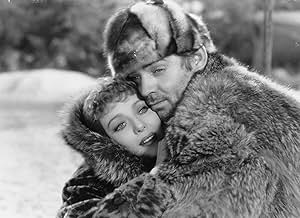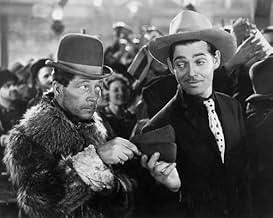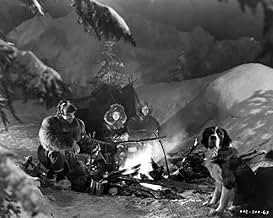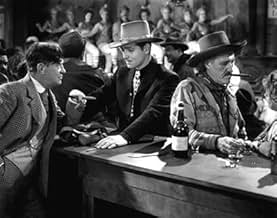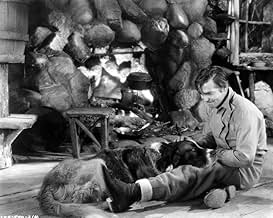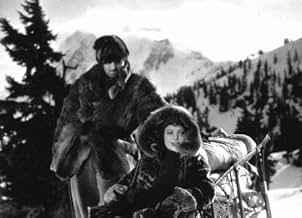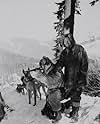IMDb रेटिंग
6.8/10
2.8 हज़ार
आपकी रेटिंग
अपनी भाषा में प्लॉट जोड़ेंDuring the Klondike Gold Rush, a traveler purchases a dog to lead the way toward the treasure, but reconsiders his journey when he finds a stranded widow.During the Klondike Gold Rush, a traveler purchases a dog to lead the way toward the treasure, but reconsiders his journey when he finds a stranded widow.During the Klondike Gold Rush, a traveler purchases a dog to lead the way toward the treasure, but reconsiders his journey when he finds a stranded widow.
- निर्देशक
- लेखक
- स्टार
- पुरस्कार
- कुल 1 जीत
Thomas E. Jackson
- 'Tex' Rickard
- (as Tommy Jackson)
George MacQuarrie
- Mounted Policeman
- (as George McQuarrie)
C.E. Anderson
- Fourth Poker Player
- (बिना क्रेडिट के)
Edwin Argus
- Dawson Townsman
- (बिना क्रेडिट के)
William Arnold
- First Faro Player
- (बिना क्रेडिट के)
फ़ीचर्ड समीक्षाएं
Gable has it all for a short while: easy pickings gold nuggets, a gorgeous girlfriend he found in the wilderness, a half-wild soul mate lead dog and a bashful wisecracking partner. But, his grasp on all of these is slippery, as the plot develops. I don't fault Hollywood for departing so flagrantly from London's story, which too was just a yarn. I found this version much more entertaining and profound, despite the stereotypical boss-sidekick relationship between Gable and Jack Oakie.
Gable seems to represent sort of an ideal adventurous entrepreneur: a riverboat gambler at heart, who is willing to take big risks and to work for his fortune when necessary, but who tries to grab all he can and beat out the competition. The chief villain is a stereotypical pretentious cutthroat tycoon: the worst kind of capitalist. In contrast, Gable recognizes certain limits in gaining his fortune and honors his commitments to his partners, be they human or animal. Loretta's creed is yet more tempered: You will get what you want only if you deserve it. See the movie to find out how these various creeds interact to determine the outcome.
This is perhaps Gable's most enjoyable role, along with those in "Mutiny on the Bounty" and "Boom Town". As in most of his best roles, Gable comes across as rakish: part hero, part scoundrel, but never dull. Like Gable, Loretta is at her physical peak at this time, making for a very romantic-looking couple.
Gable seems to represent sort of an ideal adventurous entrepreneur: a riverboat gambler at heart, who is willing to take big risks and to work for his fortune when necessary, but who tries to grab all he can and beat out the competition. The chief villain is a stereotypical pretentious cutthroat tycoon: the worst kind of capitalist. In contrast, Gable recognizes certain limits in gaining his fortune and honors his commitments to his partners, be they human or animal. Loretta's creed is yet more tempered: You will get what you want only if you deserve it. See the movie to find out how these various creeds interact to determine the outcome.
This is perhaps Gable's most enjoyable role, along with those in "Mutiny on the Bounty" and "Boom Town". As in most of his best roles, Gable comes across as rakish: part hero, part scoundrel, but never dull. Like Gable, Loretta is at her physical peak at this time, making for a very romantic-looking couple.
The Yukon Gold Rush: A savage dog and a lonely man each respond to THE CALL OF THE WILD, that primordial release of primitive urges, in their own way.
It should be understood immediately that this movie only borrows the title and a few incidents from Jack London's classic novel. And at that point the comparison between the two should end. This film, rousing & adventurous, is able to stand on its own merits. An excellent cast, fine production values (notice particularly the care with which Skagway & Dawson are depicted) and location shooting in Washington State are the film's strongest assets. The plot, meant solely for entertainment, is pure hokum...
Clark Gable brings his trademark masculinity to a role that didn't require a lot of stretching of his thespian muscles. But in essentially playing himself he is perfectly cast. One cannot overcome the suspicion that London's original story was reworked for the star. Gable had been through this before - remote setting, forces of nature, beautiful woman, adultery. Think RED DUST in the snow.
Loretta Young is the beautiful woman. From scene to scene, no matter what the hardship, she remains living proof that a first class Hollywood makeup job can withstand the worst ravages of the Klondike. This is perhaps too harsh. Like Gable, little more is required of her than to exude physicality. She is indeed a treat to the eyes, even if her inclusion in the plot is patently ludicrous. (The on screen attraction between Gable & Young wasn't faked. A daughter, ostensibly 'adopted' by Young in France, would be the result.)
As Gable's sidekick, comic Jack Oakie has one of his best screen roles. Getting to play most of his scenes strictly for laughs, he adds chuckles to the story which, one assumes, would have outraged London.
Twisting his usual pomposity to a sinister bent, English character actor Reginald Owen is memorable as the film's villain. Dangerously wicked, he makes us want to know more about this man called Smith, with money to burn and a raging temper. The screenplay, wisely, leaves his biography up to the imagination of the viewer.
Sidney Toler & Herman Bing are very good in small roles. Movie mavens will recognize Arthur Housman, veteran of many Laurel & Hardy comedy shorts, as a Skagway drunk with a surprisingly mean punch.
The affection between Gable and Buck, the great St. Bernard with whom he shares so many scenes, is obvious.
It should be understood immediately that this movie only borrows the title and a few incidents from Jack London's classic novel. And at that point the comparison between the two should end. This film, rousing & adventurous, is able to stand on its own merits. An excellent cast, fine production values (notice particularly the care with which Skagway & Dawson are depicted) and location shooting in Washington State are the film's strongest assets. The plot, meant solely for entertainment, is pure hokum...
Clark Gable brings his trademark masculinity to a role that didn't require a lot of stretching of his thespian muscles. But in essentially playing himself he is perfectly cast. One cannot overcome the suspicion that London's original story was reworked for the star. Gable had been through this before - remote setting, forces of nature, beautiful woman, adultery. Think RED DUST in the snow.
Loretta Young is the beautiful woman. From scene to scene, no matter what the hardship, she remains living proof that a first class Hollywood makeup job can withstand the worst ravages of the Klondike. This is perhaps too harsh. Like Gable, little more is required of her than to exude physicality. She is indeed a treat to the eyes, even if her inclusion in the plot is patently ludicrous. (The on screen attraction between Gable & Young wasn't faked. A daughter, ostensibly 'adopted' by Young in France, would be the result.)
As Gable's sidekick, comic Jack Oakie has one of his best screen roles. Getting to play most of his scenes strictly for laughs, he adds chuckles to the story which, one assumes, would have outraged London.
Twisting his usual pomposity to a sinister bent, English character actor Reginald Owen is memorable as the film's villain. Dangerously wicked, he makes us want to know more about this man called Smith, with money to burn and a raging temper. The screenplay, wisely, leaves his biography up to the imagination of the viewer.
Sidney Toler & Herman Bing are very good in small roles. Movie mavens will recognize Arthur Housman, veteran of many Laurel & Hardy comedy shorts, as a Skagway drunk with a surprisingly mean punch.
The affection between Gable and Buck, the great St. Bernard with whom he shares so many scenes, is obvious.
Wiliam Wellman is the director at the helm of this version of Jack London's immensely popular novel. As an adventure, this movie offers a lot of fun because of the enormous appeal of its star, Clark Gable. He is a man's man. Mr. Gable projected such an aura about himself that he carried from film to film, making him one of the favorites of all audiences. The gold rush is presented as it should have been for the people that went in search of riches in the inhospitable confines of Alaska.
In this version, Loretta Young plays Claire Blake, the woman who conquered Jack Thornton's heart. The rumored affair between Ms. Young and Mr. Gable is fun to look at. What's real, and what not? It's up to the stars to know and for us, the viewers, to guess. Ms. Young and Mr. Gable were appealing players, as they prove in this film.
In other roles, Jack Oakie, Reginald Owen, Frank Conroy, and other old faces from films of the era make wonderful appearances. Above all, Buck, the great St. Bernard dog in the film is amazing. It's a joy to watch Mr. Gable's scenes with Buck as they compliment one another in that frigid background.
In this version, Loretta Young plays Claire Blake, the woman who conquered Jack Thornton's heart. The rumored affair between Ms. Young and Mr. Gable is fun to look at. What's real, and what not? It's up to the stars to know and for us, the viewers, to guess. Ms. Young and Mr. Gable were appealing players, as they prove in this film.
In other roles, Jack Oakie, Reginald Owen, Frank Conroy, and other old faces from films of the era make wonderful appearances. Above all, Buck, the great St. Bernard dog in the film is amazing. It's a joy to watch Mr. Gable's scenes with Buck as they compliment one another in that frigid background.
Clark Gable meets Loretta Young in this 1930s adaptation of Jack London's The Call of the Wild, which takes place in Alaskan territory. I've never read the book, but I can only imagine that this was probably not very faithful to the novel, due to its emphasis of comic relief by supporting actor Jack Oakie. This is the movie that changed Clark and Loretta's life, as they fell in love during the making of this film, and she went away in private to have his baby - a fact she never told the public. While that may be neither here nor there, in reviewing this film, it's pretty evident that something was going on, by their quiet scenes together, which are very intimate and deep, considering this is a 1930s film. The plot revolves around a map that is needed to find a gold mine. Her husband, yes her husband, was the owner of the map, but Clark and Jack go after the gold mine, with Jack's memory and a rough sketch of it to use. They find Loretta alone, after her husband has been lost in the wilderness looking for help. Reginald Owen is very good and memorable as a nemesis in trying to find the gold mine too, when he learns of it. The production values and performances are solid and deliver the goods, but its corny comic relief mars the film's attempt to hit the mark with viewers, especially with its abrupt ending. I thought the novel was mainly about the dog, but, while the dog, who Clark is attached to, does have some screen time, the film doesn't feel like a dog film. The producers were probably thinking that would alienate some viewers, so they centered on pairing attractive leads Clark and Loretta together and Jack Oakie's one-liners. While I liked the film on the whole for Loretta's loveliness, memorable love scenes between her and Clark, and Reginald Owen's credible contribution to the film, I still feel it misses the mark for a completely fulfilling movie experience.
The last time Clark Gable got loaned out for a film was the year before and he won an Academy Award. This time Louis B. Mayer got a good price for him from Fox for Call of the Wild.
Fox also did something unusual in that the film was shot on location with the mountains of Washington state serving as the Canadian Rockies. Some really stunning cinematography is done for this film, especially in the river scenes. Too bad color was not in use back then.
Watching Gable, Loretta Young, and Jack Oakie on a raft pulling it to shore in what must have been freezing water reminded me so much of the stunts Gable did for The Misfits. Of course back then he had the youth and vim and vigor to do such things.
The film served as the meeting place for Gable and Young they carried on a torrid affair that resulted in Loretta Young giving birth. Back then it would have been a career death sentence for a star to give birth to an out of wedlock daughter, especially for the very Catholic Ms. Young. A whole elaborate charade was concocted with Loretta adopting her own daughter as a single mom.
No Oscars this time for Gable, but a good strong performance as a rugged prospector up in the Klondike during the gold rush. Of course being involved with Loretta sure helped in the love scenes. Young plays a woman apparently abandoned in the snow by her husband who's presumed dead.
Jack Oakie as Gable's sidekick and Reginald Owen as the English villain engaged in some claim jumping are the best two of the supporting actors. Of the human variety.
Then there's Buck, Gable's trusty St. Bernard who he rescues from Reginald Owen. In that rugged country good sled dogs can come in mighty handy and Buck sure proves his worth. Up there, they are indeed man's best friend.
Fox also did something unusual in that the film was shot on location with the mountains of Washington state serving as the Canadian Rockies. Some really stunning cinematography is done for this film, especially in the river scenes. Too bad color was not in use back then.
Watching Gable, Loretta Young, and Jack Oakie on a raft pulling it to shore in what must have been freezing water reminded me so much of the stunts Gable did for The Misfits. Of course back then he had the youth and vim and vigor to do such things.
The film served as the meeting place for Gable and Young they carried on a torrid affair that resulted in Loretta Young giving birth. Back then it would have been a career death sentence for a star to give birth to an out of wedlock daughter, especially for the very Catholic Ms. Young. A whole elaborate charade was concocted with Loretta adopting her own daughter as a single mom.
No Oscars this time for Gable, but a good strong performance as a rugged prospector up in the Klondike during the gold rush. Of course being involved with Loretta sure helped in the love scenes. Young plays a woman apparently abandoned in the snow by her husband who's presumed dead.
Jack Oakie as Gable's sidekick and Reginald Owen as the English villain engaged in some claim jumping are the best two of the supporting actors. Of the human variety.
Then there's Buck, Gable's trusty St. Bernard who he rescues from Reginald Owen. In that rugged country good sled dogs can come in mighty handy and Buck sure proves his worth. Up there, they are indeed man's best friend.
क्या आपको पता है
- ट्रिवियाLike many films of the era, this production was originally slated to film in the Southern Sierra Nevada near Sonora. In fact, production had already begun when a warm front melted the snow and forced a hasty and expensive move to Washington state.
- गूफ़Why call this a goof? It's just a funny way of saying he'd knife someone.
- भाव
Jack Thornton: Me? I'll take bourbon. It kills you slower, but a lot more pleasant like.
- इसके अलावा अन्य वर्जनOriginally released at 95 minutes; later cut to 81 minutes for a re-issue. For many years only the cut re-issue version was available for television showings, and it is also the version released on DVD in 2006 as part of the Clark Gable Collection. The original length version remained unseen until it was released on blu-ray in 2013.
- कनेक्शनFeatured in Only the Lonely (1991)
टॉप पसंद
रेटिंग देने के लिए साइन-इन करें और वैयक्तिकृत सुझावों के लिए वॉचलिस्ट करें
- How long is Call of the Wild?Alexa द्वारा संचालित
विवरण
- रिलीज़ की तारीख़
- कंट्री ऑफ़ ओरिजिन
- भाषाएं
- इस रूप में भी जाना जाता है
- Un grito en la selva
- फ़िल्माने की जगहें
- उत्पादन कंपनी
- IMDbPro पर और कंपनी क्रेडिट देखें
- चलने की अवधि
- 1 घं 35 मि(95 min)
- रंग
- ध्वनि मिश्रण
- पक्ष अनुपात
- 1.37 : 1
इस पेज में योगदान दें
किसी बदलाव का सुझाव दें या अनुपलब्ध कॉन्टेंट जोड़ें


